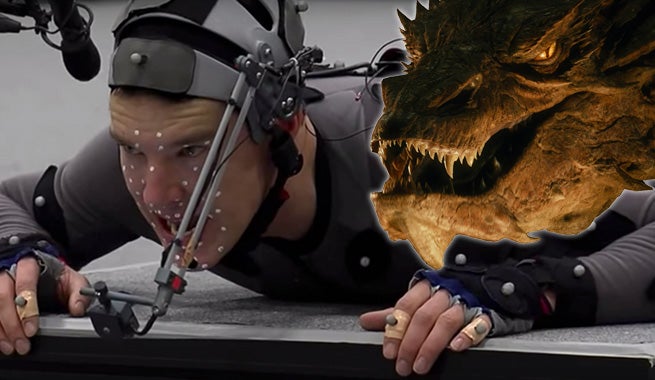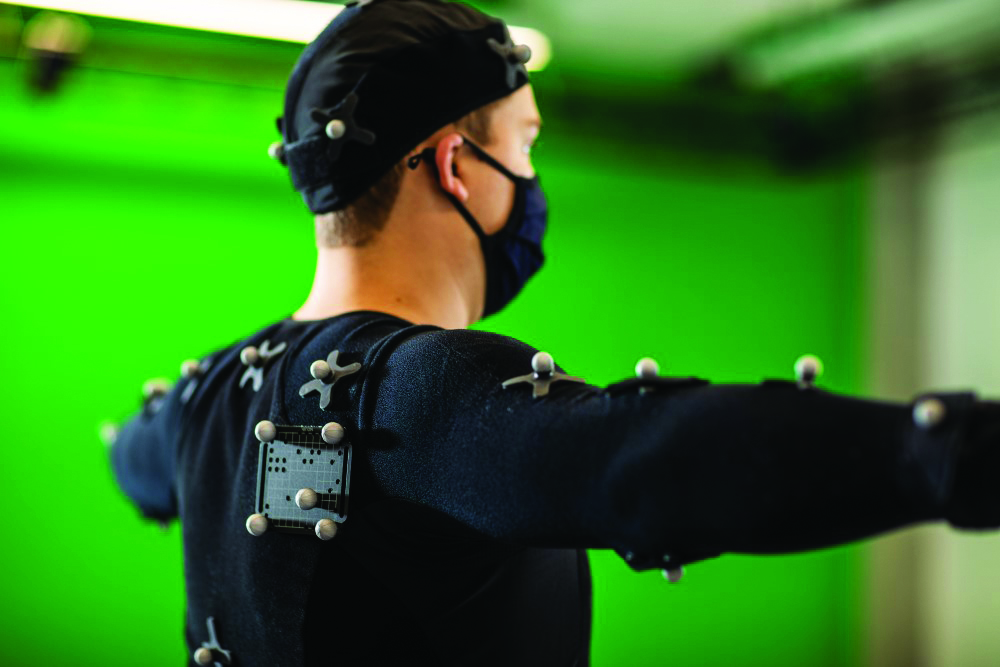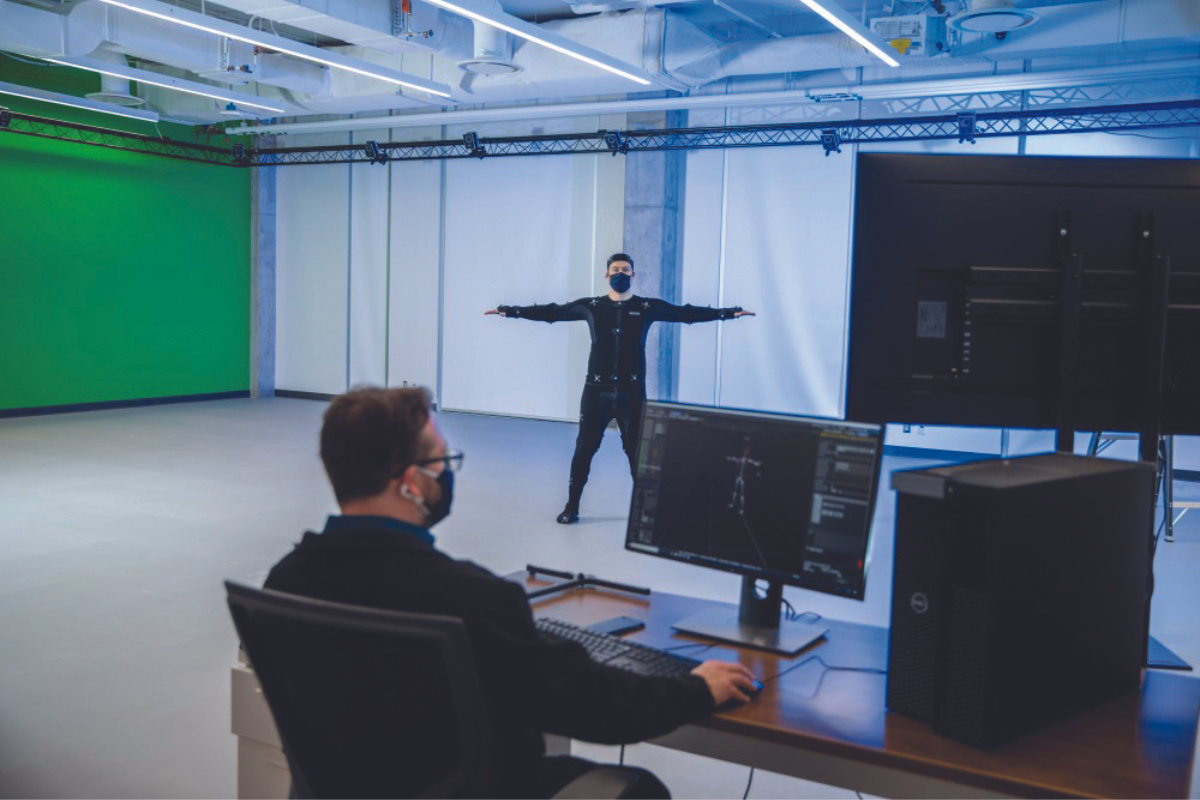Detroit: Become Human, The Last of Us and Mortal Kombat. The Hobbit series, Guardians of the Galaxy and Thanos in Avengers: Infinity War and Endgame. These are all examples of award-winning and record-breaking media that captured the emotions and facial expressions of their actors using motion capture technology. For many years, this technology was only available in studios and places that could afford it, like Los Angeles and later, Vancouver. Electronic Arts, one of the largest video game companies in the world, has a motion capture lab to match. Theirs has over 100 cameras and has been used to create over 200 video games.
But in Edmonton, the scene is starting to expand. Tucked away in NAIT’s Productivity and Innovation Centre (PIC) is a 2,000 sq. ft. motion capture studio. Skylar Zerr, Studio Technologist and Animator, came from the aforementioned scene in Vancouver, with roughly a decade’s worth of experience in the art of motion capture before packing his bags for Alberta’s capital. “You can’t buy houses [in Vancouver],” Zerr shared with a laugh. “[With a] growing family, I had to. It was time.”
The Motion Capture studio was funded by The Canada Foundation for Innovation, the Government of Alberta’s Research Capacity Program and NAIT in 2018 and came online in 2021. In February of 2023, the Nugget got to visit the studio and see how things worked.
Twenty-one infrared cameras are aimed within a large square. Props, like a wooden stick Zerr showed us, are covered in dot-shaped stickers. As Zerr explained, “We have infrared cameras that are shooting laser beams on the [dots] and they’re reflecting back to the cameras, right? So once the [cameras] identify and agree to where a marker is, it can reconstruct that marker.“
“What we’re actually doing in here is mapping a human skeleton,” said Zerr. “When you have that on an entire person, you can imagine you can reconstruct the person. And then you have a virtual digital representation of yourself, with your proportions and everything.”

There’s a very popular meme of Benedict Cumberbatch crawling across the floor while filming The Hobbit in what seems to be a skin-tight suit with dots everywhere. While the pre-production version is amusing, once the technology is applied, the result is realistic and creates the terrifying image of Smaug.
The stick Zerr held was just a stick, but with the science of Unreal Engine, the software used to create several AAA titles such as Batman: Arkham City, Fortnite and Star Wars: Fallen Order, the stick becomes something much more. The camera captures the positions of each of the dots, and Zerr and his team use Unreal Engine to map the distance between each. The software is then able to transform a simple stick into a flashlight by mapping the distance between each of the dots. When the actor holding the stick moves it around, so does the flashlight and the accompanying beam of light.
“This creates that direct relationship between the character and the person so that [the motion capture] doing the work for me in real time, so that’s why especially game companies choose motion capture,” Zerr said.
The studio can also track the movement of a body. Actors wear suits and gloves in various sizes. “[The dots] define all the knuckles and the hand and the shoulders, the torso, the head and the elbows. [Which] are all important. The ankles,” Zerr explained, pointing to the different markers on some of the suits. “We even capture the toe flex that happens when you step.” All of these components are vital to creating a realistic movement without looking too jarring, especially when creating a humanoid model.

There’s also a variety of furniture in the room, such as ladders, boxes and treadmills. These items help actors interact with something physical to create a more stimulating performance—like running through an empty city fighting off zombies or climbing to safety to avoid a fire.
It takes little time to realize the appeal of the studio and the potential for video game lovers. But the studio doesn’t only capture action heroes fighting zombies and doing barrel rolls. Bernard Johnson, Business Development Lead at NAIT, couldn’t divulge exactly what clients they’ve worked with, but he did confirm they’ve worked with other universities, like the University of Alberta, for data validation.
“This isn’t only used for entertainment; it’s used for scientific research. We can actually use this and track the motion of people, which is obviously important when you’re doing medical evaluations, especially on how somebody’s walking,” Zerr said. “Things are going good,” added Johnson.
This studio serves as a pioneer of what seems to be a growing market and need for the developer industry in Edmonton. The video game industry in Edmonton has exploded. It began with BioWare, the creators of the iconic series Mass Effect.
Now, Zerr says, developers are living in Edmonton and creating for developers in other provinces. “So I know that there are people that work for Epic here. There are people that work for Electronic Arts. They work in the Epcor tower with BioWare.” According to Zerr, this has an impact on the local scene. “There’s talent that’s coming here and working for companies that don’t have bases here yet, so that’s definitely a positive.”
Skylar Zerr came to Edmonton looking for more affordability but has found something he may not have expected: possibility. “I’m passionate about the city. That’s partially why I’m doing this. I’m an advocate for Alberta specifically as well. Why should Vancouver get all the thunder, you know? I’m competitive with my previous city. I want to steal some of that and bring it here because it’s disproportionate, right? There’s so many talented people that are here and the infrastructure like this [studio] is here.”
“This could be a draw for a lot of these enterprises. Small to medium game enterprises could build their entire game in here and save thousands of dollars along the way, while maintaining that elevated look,” said Zerr.

In early February, NAIT hosted the Edmonton Global Game Jam in PIC. The event served as a collaborative effort for indie and small developers to build a game within a 48-hour time limit. Participants could also sign up for a tour of the Motion Capture Studio.
According to Johnson, the event was very successful. “[We got some reactions like], this is going to add so much value to the ecosystem, like sign us up. How can we possibly get access to this facility?” Johnson says this reaction could be a sign for the future. “[We want to be] a bit more strategic about the asset that we have on campus. As well as how we can add value back to the ecosystem and to elevate it, because there is a lot of talent and we have some great resources here that can be used to develop some impactful games.”
Studios like the one at NAIT make it so students can get excited about working in cutting-edge motion capture technology, without needing to move to a city like Vancouver or Los Angeles. As Zerr said, “You can make it happen here. It is a young and funny industry here, but you can make it happen. You can be a part of that platform.”






